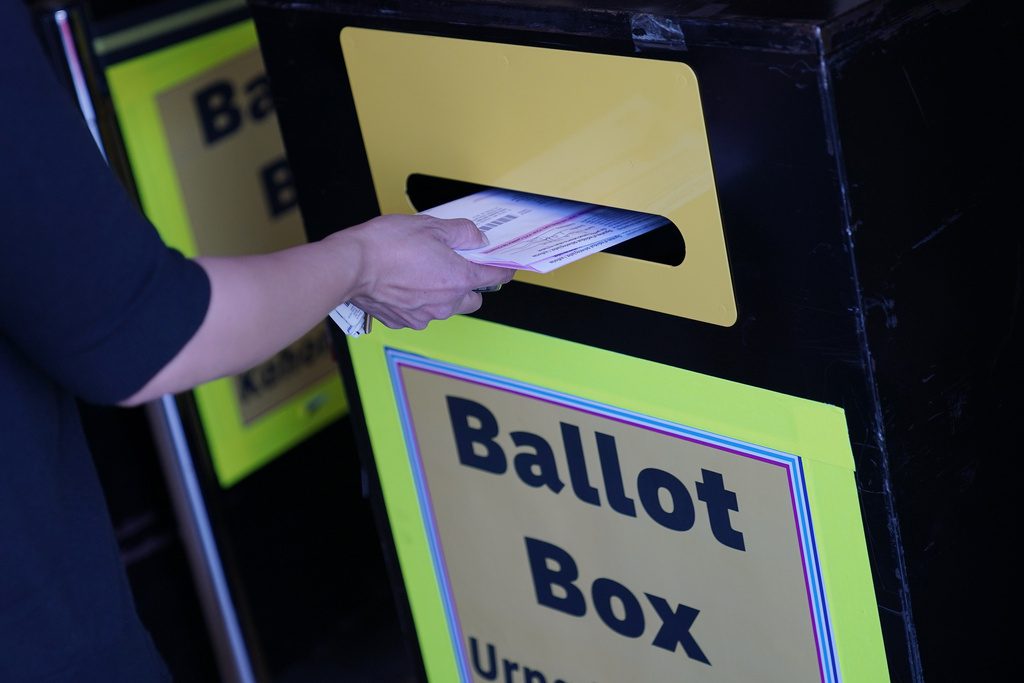
FILE - A person places mail-in ballots at a mail-in ballot drop box at the Clark County Election Department, Oct. 29, 2020, in Las Vegas. (AP Photo/John Locher)
Since 2020, when the country was dealing with the worst of the COVID-19 pandemic, most Nevada voters have used mail ballots to cast their votes. It was so effective in ensuring everyone got the ability to vote that in 2022, lawmakers made it so that all active voters are sent a mail ballot come election season.
If it’s your first time voting, make sure to check our step-by-step guide.
If you’re voting for the first time by mail in Nevada — or need a refresher — keep reading.
The first thing to know is that the election department is tasked with mailing ballots to everyone who is registered to vote in the state. Officials are required to begin sending them out no later than 20 days before Election Day. If you do not receive your mail ballot by the start of the early voting period — which begins Oct. 19 — and you did not opt out, call your county election department.
So you’ve received your ballot in the mail. Now what?
DO:
- Double check it’s yours and your information — name, address, and party affiliation — is correct.
- Follow the instructions on the ballot.
- Make sure you use a black pen to fill the bubbles.
- Sign the back of the envelope (important!).
- Fold your completed ballot into the postage-paid return envelope provided specifically for you, showing your name and address.
- Send it either by USPS — it must be postmarked by 7 p.m. Nov. 5 — or by dropping it off in a mail ballot drop-off box at a voting site.
- Check your ballot’s status at nvsos.gov/votersearch to make sure the election department has received it and has been counted.
Here’s a very important heads up: Some mail ballots might be flagged, or rejected, if they are missing a signature or the automated system couldn’t read the signature. That’s why it’s so important to include your signature, and to do so in the neatest way possible.
Flagged ballots will have to be “cured” before being tabulated. To “cure” their ballot, voters must go to the election department in person and prove their identity no later than 5 p.m. on the sixth day after Election Day.
DON’T:
- Vote twice. This might seem obvious, but every American gets one vote. Voting in person and by mail (or if you received two mail ballots) will not make your vote count twice — it is a felony.
- Use third-party organizations to return your ballot. This had previously been illegal, but the passage of AB 321 in 2021 made it legal to collect ballots for others. Election officials don’t recommend this activity, even if organizations do it well intentioned, the concerns and risks of voter coercion and inability to guarantee that ballots make it to the drop-off box are too high.
- Fill out a ballot that isn’t yours. If you get a mail ballot meant for a previous tenant that once lived where you live, you can notify your county clerk by submitting a residence discrepancy report.
You’ve got mail, or not…
As long as you register to vote two weeks before Election Day and you haven’t opted out, you can expect to automatically receive a mail ballot.
If you decide that you do not want a mail ballot, you can opt out either online by updating your voter information and preferences, or by printing, completing, and mailing a “mail ballot preference form” to the county election department. You must submit the request no later than 60 days before Election Day. That’s Sept. 5.
If you get a mail ballot but decide it would be more meaningful or convenient for you to vote in person, you can surrender the mail ballot when you go to the voting site. It’s not required to surrender your mail ballot, but you will have to sign an affirmation that you are not voting more than once in the same election.
Inactive voters are not sent mail ballots. You may become an “inactive” voter if the Postal Service notifies the election department that a voter has moved and the address was not updated within 30 days.
Inactive voters may still vote in person at any voting site early or on Election Day. Poll workers will then ask for an updated address and become “active” again. You can check your voter status online.
Are you ready to vote? Make sure to check your voter registration status, see who’s on your ballot, and make a voting plan here.

A pesar de las mentiras sobre el fraude electoral, la votación anticipada se ha desarrollado en gran medida sin problemas hasta ahora en Nevada
En medio de continuas mentiras y conspiraciones sobre fraude electoral por parte de círculos de extrema derecha, los nevadenses están expresando...

Despite lies about voter fraud, early voting has been largely smooth so far in Nevada
Amid ongoing lies and conspiracies about voter fraud from far-right circles, Nevadans are expressing confidence in the state’s election system and...

Opinion: Question 7 would create barriers for seniors and potentially lead to voters being turned away
Question 7 is an unnecessary barrier to voting. Simply put, there is no widespread voter fraud in Nevada; it is not something that has ever...

NV Supreme Court upholds ruling on mail ballots received post-Election Day
The Nevada Supreme Court noted in its opinion, which was posted by Democracy Docket, that the RNC identified 24 non-postmarked mail ballots that...

What to Know About Question 7 on Nevada’s Ballot






